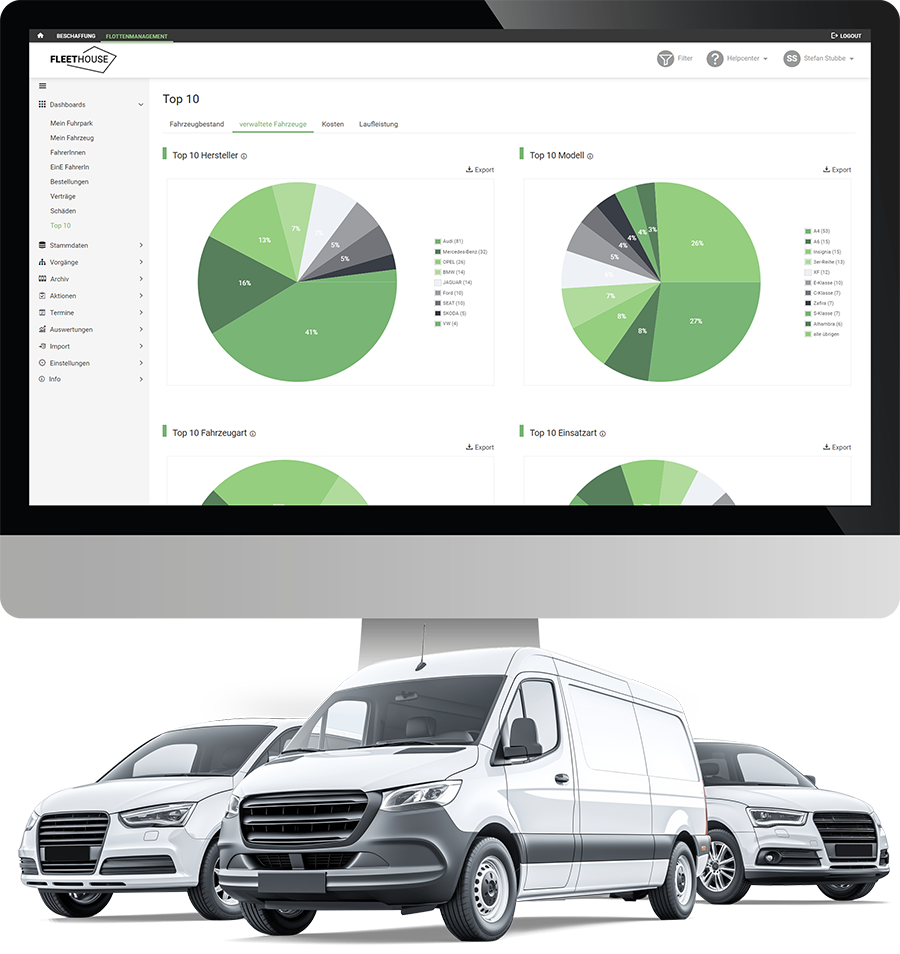Company car leasing – one of the most popular forms of financing for vehicle fleets. It not only protects the company’s liquidity, but also offers tax advantages. But how does vehicle leasing work and what are the different types of contract? In this article, we get to the bottom of the concept and give you tips for commercial leasing in your fleet.
Contents
How does company car leasing work?
Company car leasing is a form of financing. In this case, a company rents vehicles from a lessor for a predetermined period and pays regular leasing installments in return. In contrast to purchasing a vehicle, the company has no ownership rights to the vehicles when leasing, as these remain with the lessor.
Leasing company cars makes it easy to expand or renew the company’s vehicle fleet without having to make large investments. There are different types of leasing contracts, including mileage leasing and residual value leasing, which can be selected according to the company’s needs. At the end of the leasing contract, the vehicle can be returned, the contract extended or, if necessary, the vehicle purchased.
What are the advantages of company car leasing?
As already mentioned, leasing for company cars is one of the most popular forms of financing for companies. This is due to the following advantages, among others:
- Planning security thanks to monthly leasing installments
With company car leasing, no high initial investment is required, as is the case with the purchase of vehicles. Instead, companies pay regular leasing installments, making the costs for the leasing period precisely calculable and transparent. This protects liquidity and increases financial flexibility. The remaining capital can be used for other business purposes, for example.
- Flexible terms
Leasing contracts can be concluded for different lengths of time. Leasing periods of 24 to 48 months are common, but 12 or 60 months are also possible. In the case of mileage leasing, which we will discuss later in the article, the mileage can also be set individually. All these factors determine the amount of the monthly leasing rate.
- Tax advantages
Companies can deduct the monthly leasing installments from their taxes as operating expenses and thus reduce their tax burden. In addition, the equity ratio is not burdened by a leased vehicle, as this is not shown in the balance sheet, but only in the income statementopen_in_new .
- Current vehicle models
Thanks to company car leasing, your own vehicle fleet can be regularly renewed and kept up to date. At the end of the leasing contract, the vehicle is simply returned and exchanged for a newer, more efficient model with more innovative technologies. These usually also have lower fuel consumption and higher environmental standards than their predecessors. This enables companies to keep pace with the latest technological developments and provide their employees with advanced and reliable vehicles.
- Simplified administration
Company car leasing can reduce the administrative and bureaucratic burden on the vehicle fleet. Lessors often take care of vehicle registration and insurance. Many lessors also offer the option of concluding a maintenance contract. This covers all costs arising from inspections and signs of wear and tear. This also reduces the risk of repairs to a minimum.

What are the disadvantages of commercial leasing?
In addition to all the advantages, companies should also consider the possible disadvantages of commercial leasing before signing a contract. These include:
- No right of ownership
With company car leasing, companies do not acquire ownership of the vehicle. The vehicle remains the property of the lessor for the entire term of the contract and after it is returned.
- Premature contract termination only possible with difficulty
As a rule, it is not permitted to terminate the leasing contract prematurelyopen_in_new . If there is a serious reason, which the lessor agrees to, there is the possibility of extraordinary termination or a termination agreement. However, this results in high costs for the lessee, which are calculated from the outstanding leasing installments and the residual value of the vehicle. In some cases, the leasing contract can also be transferred to a lessee. This also incurs costs and the lessor must agree to the transfer.
- Condition of the vehicle on return
When the leasing contract is concluded, it should already be determined which defects are accepted as normal wear and tear and which are considered excessive wear and tear or damage. This is because if damage that goes beyond normal wear and tear is discovered on return, the repair costs can be charged to the lessee. In addition to regular maintenance of the leased vehicle, damage should also be repaired before the vehicle is returned.
- Conversions only possible to a limited extent
As the lessor has the right of ownership, it is difficult to make modifications or adaptations to the leased vehicleopen_in_new . While sticking the company logo on the vehicle, for example, is not a problem, other modifications require the consent of the lessor. In addition, these must be reversed at the end of the leasing term.
How can software support business car leasing?
By using a software solution to support vehicle leasing, fleet managers can digitize and optimize the entire leasing process. Fleet software helps to keep an eye on all costs, meet deadlines and make informed decisions. Automating the tasks associated with company car leasing saves time and resources.
- Offer management: Software can be used to view and compare offers from different lessors. This allows fleet managers to quickly and easily determine the best conditions and prices.
- Management of contracts and documents: Fleet software supports the management of leasing contracts and all relevant documents. Information such as contract term, mileage limit, monthly installment or insurance documents are recorded and monitored centrally.
- Cost control: Fleet managers can track and analyze monthly leasing rates, insurance costs, maintenance costs, consumption and other expenses with a digital solution.
- Deadline reminders: Fleet software reminds you of important dates and deadlines in connection with vehicle leasing, such as contract extensions, mileage limits or maintenance intervals.
- Reports and evaluations: By creating reports and evaluations, fleet managers can analyze important key figures such as leasing costs per vehicle, total costs per kilometer or contract terms and thus make well-founded decisions. This also makes it much easier to compare the contractually agreed kilometers and the kilometers actually driven.

Manage vehicles digitally
Complete all tasks relating to your vehicles and receive reminders of important dates, such as the end of leasing contracts.
What types of commercial leasing contracts are there?
In general, there are two types of leasing for company cars: mileage leasing and residual value leasing. But what are the differences?
Kilometer leasing
With mileage leasing, the monthly leasing installments are calculated on the basis of a predetermined mileage. This means that the lessee agrees a certain number of kilometers in advance with the lessor that he is allowed to drive with the vehicle during the term. The upper mileage limit is then specified in the leasing contract. The following applies: the lower the annual mileage, the lower the installments.
Excess and shortfall kilometers are treated as follows: If the agreed mileage is exceeded, additional charges are incurred for the extra kilometers. The costs amount to several cents per kilometer, usually between 5 and 15 cents. Some leasing companies grant a goodwill amount of kilometers that may be driven more without having to make additional payments. If the number of kilometers driven at the end of the term is lower than agreed in advance, the lessee receives a refund for the shortfall.
During the lease term, it is the responsibility of the lessee to monitor the kilometers driven and ensure that they remain within the agreed kilometer limit. Leased vehicles with fewer kilometers should be assigned longer routes, while leased vehicles with more kilometers should be assigned shorter routes. Even before signing the leasing contract, fleet managers should estimate the expected mileage as accurately as possible.
Residual value leasing
With residual value leasing, the lessee pays monthly leasing installments during the term of the contract based on the difference between the new price of the vehicle and the expected residual value. If the lessee decides to buy the vehicle at the end of the term, he pays the previously determined residual value. The residual value is agreed between the lessor and lessee when the contract is concluded.
The installments are often lower with residual value leasing and therefore seem very tempting. However, there is one major disadvantage: the residual value risk is borne by the lessee. If the actual market value of the vehicle at the end of the term is lower than the previously agreed residual value, the difference must be paid by the lessee. And this can be costly, because developments in the used car market and the economy, as well as dealing with damage and defects, make this difficult to calculate.
Company car leasing vs. car subscription
Terms, predictable rates and a large selection of different models make car subscriptions increasingly attractive for many fleets. But what are the differences?
In contrast to company car leasing, car subscriptions generally have shorter terms and offer more flexibility, as the vehicle can be changed more frequently depending on the type of subscription. With some providers, the terms start from as little as one month. While a leasing contract incurs additional costs for taxes and insurance, these expenses are already covered in the monthly installment. However, they are also higher as a result.
Leasing for company cars is worthwhile if you
- need the vehicle for a longer period of time
- want to commit to a model for longer and are not planning to change vehicles within the contract period
- prefer lower rates and take care of registration, insurance and maintenance in return
A car subscription is worthwhile if you
- only need the vehicle for a short period of time
- want to remain flexible and you value a termination option
- want to test new models and drive types first
Subscribe to company car?
With Fleethouse and FINN, you can subscribe to your company cars in seconds. With no hidden costs and a term of just one month.
What are the costs of leasing a company car?
When leasing a company car, there are various costs that should be taken into account when planning your budget. It is advisable to compare offers from different lessors and check the terms of the contract carefully to get a better understanding of the costs and avoid possible hidden charges.
- Leasing installments: These are the main costs when leasing a vehicle. They are based on factors such as the vehicle price, the contract term, the mileage limit and the expected residual value of the vehicle.
- Down payment: Some leasing contracts may require a down payment. The amount varies from leasing company to leasing company and depends, among other things, on the vehicle price and the individual agreements with the lessor.
- Car insurance: As a rule, the lessee is responsible for the car insurance of the leased vehicle. The cost of insurance depends on several individual factors, such as the no-claims bonus class, the vehicle model or the insurance company
- Servicing and maintenance: The vehicle must be maintained during the lease term. Regular maintenanceis usually the responsibility of the lessee. This includes inspections, oil changes, tire changes and other routine maintenance work. More and more leasing companies are offering full-service leasingopen_in_new , which includes the costs of MOTs, inspections, tire changes and wear and tear repairs.
- Repairs: If damage occurs to the vehicle that goes beyond normal wear and tear, the lessee bears the costs. This includes repairs due to accidents, damage or improper use of the vehicle.
- Additional fees: In some cases, additional fees may apply, such as for early termination of the contract or for excess mileage. These fees vary depending on the lessor and the individual terms of the contract.
Typical mistakes in company car leasing and how you can avoid them
There are a few pitfalls to watch out for when leasing a company car to ensure that everything runs smoothly both during the term of the contract and when the car is returned.
Mistake 1: Failure to analyze individual requirements
A common mistake is to enter into a company car lease without a thorough analysis of the individual requirements and needs of the fleet. Before signing a leasing contract, you should check and weigh up vehicle usage, mileage and vehicle models. This way you can ensure that the leasing contract really meets your needs.
Mistake 2: Not comparing offers
It is often the case that fleet managers do not take enough time to weigh up different leasing offers. However, different providers also have different conditions and prices. Therefore, take the time to compare different offers and determine the best conditions and prices for your fleet. Take into account not only the monthly rates, but also other factors such as contract term, mileage limit and additional services.
Error 3: Insufficient contract review
Another mistake is not reading and checking the leasing contract carefully. Contract details such as term, monthly installments, mileage limit, insurance, maintenance and possible fees should be checked thoroughly to avoid unpleasant surprises. Read the contract thoroughly and clarify all open questions to your satisfaction. If necessary, you can also consult a legal expert.
Error 4: Exceeding the mileage limit
A frequent source of error, which is also associated with additional costs, is exceeding the agreed mileage limit. If the actual mileage is higher than contractually agreed, additional costs may be incurred for the extra kilometers. Therefore, try to estimate your annual mileage as accurately and realistically as possible and select an appropriate mileage limit in the contract.
Error 5: Irregular or no maintenance
Irregular maintenance and servicing of the leased vehicle is also one of the mistakes that should be avoided and that lead to additional costs or restrictions in the return process. Therefore, make sure that you have regular maintenance carried out in accordance with the manufacturer’s specifications and document this properly.

What steps need to be taken when concluding a leasing contract?
You should consider the following steps when concluding a leasing contract:
- Needs analysis: First think about the requirements of your fleet and the type of vehicle you need. Take into account factors such as vehicle type, size, equipment and budget. Also check which type of leasing – whether mileage leasing or residual value leasing – is suitable for you.
- Research and obtain offers: Compare different lessors and obtain several offers. Pay attention not only to the monthly rates, but also to the contract terms, mileage limits, insurance options and any additional services.
- Contract negotiation: As soon as you have decided on a lessor and a vehicle, negotiate the terms of the contract such as the term, monthly installments and mileage limit. Make sure that all agreements are recorded in writing.
- Credit check: The lessor usually carries out a credit checkopen_in_new to check your creditworthiness. Therefore, make sure that the company’s financial situation meets the lessor’s requirements.
- Signing the contract: After successful negotiations and a credit check, you can sign the leasing contract. Read the contract carefully and make sure that all agreements are correct and understandable.
What should I look out for when returning a leased vehicle?
To ensure that the return of the leased vehicle runs as smoothly as possible, it is advisable to follow the steps below:
- Vehicle inspection and repair of damage: Before returning the vehicle, you should have it inspected to assess its condition. If damage or signs of wear and tear have occurred during the leasing period, have them repaired before returning the vehicle. If the lessor charges you for the repair, it will often be more expensive. Also clean the car thoroughly inside and out, because first impressions count.
- Restore the vehicle to its original condition: If you have put your company logo on the car, replaced the rims or made other changes to the vehicle, then these should be reversed before handover. Also remove all personal items from the vehicle.
- Arrange a return date: Contact the leasing company in good time and arrange a return date.
- Return all documents and accessories: Remember to bring all documents such as vehicle documents, service booklets and operating instructions with you on the day of return. You should also have additional items such as navigation devices and CDs with you.
- Read the return protocol carefully: When returning the leased vehicle, the condition of the car, the mileage and any defects and damage should be recorded in a document. Read this thoroughly and clarify any open questions. If you do not agree with any defects, this should also be recorded in the report.
Arrange an online consultation appointment
Arrange your personal consultation appointment now. You can easily select a suitable appointment using our booking tool.
FAQ - Frequently asked questions about company car leasing
The residual value of a vehicle is the estimated value of the vehicle at the end of a certain period, e.g. at the end of a leasing contract or a financing agreement. It is the amount that the vehicle is expected to be worth after all payments and costs have been taken into account. The residual value is determined based on various factors, such as the vehicle model, year of manufacture, mileage, condition of the vehicle and the current market value of comparable vehicles.
The leasing factor indicates the ratio between the monthly leasing rate and the list price of the vehicle. It is usually expressed as a percentage. The leasing factor can be used to compare different leasing offers and to better assess the attractiveness of a leasing contract. A low leasing factor means that the monthly rate is relatively cheap in relation to the value of the vehicle. A high leasing factor, on the other hand, indicates a higher monthly charge.
A lease return is a vehicle that is returned to the lessor at the end of the lease term.
Commercial leasing is an attractive form of financing for start-ups and the self-employed, as liquidity is protected and costs can be planned. However, proof of creditworthiness is required when concluding a leasing contract. In addition, the business must have been in existence for at least six months, in some cases even 12 months. If you are still in the early stages of setting up your business and therefore cannot provide a business analysis (BWA), you usually have the option of paying a deposit or down payment or providing proof of a guarantee. You can find out what else founders need to consider in our article Leasing for start-ups.
The company car leasing calculator is an online application or software that takes various parameters into account, such as the type of vehicle, the term of the leasing contract, the value of the vehicle, the expected mileage per year, the amount of the down payment and other relevant factors.
To calculate the actual cost of a company car, you need to consider the following:
- monthly leasing installment
- Fuel costs
- Insurance costs
- Maintenance and repair costs
- Taxes
- Loss of value, etc.
To calculate the total cost, you would need to combine these factors and add up the total cost over the entire lease term of the vehicle. It is advisable to carry out these calculations with a professional accountant or financial advisor as the exact cost may vary depending on individual circumstances. There are also online calculators and tools that can help you calculate the total cost of a company car.
The most important facts about company car leasing
Leasing company vehicles offers planning security thanks to monthly leasing rates, flexible terms, tax advantages and access to the latest vehicle models.
A distinction can be made between mileage leasing and residual value leasing. Although the latter usually offers more attractive rates, the residual value risk lies with the lessee.
A software solution can facilitate offer and contract management, cost control and deadline compliance during the leasing process.
Further Fleet Knowledge
If you liked this article and would like to know more about this topic, we recommend these articles.

Leasing returns: advantages for the company fleet



